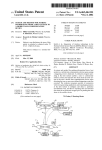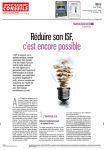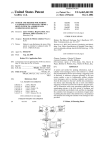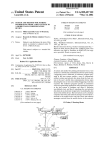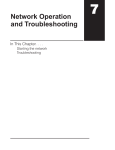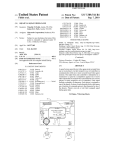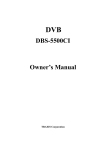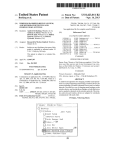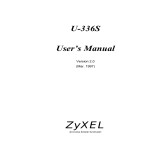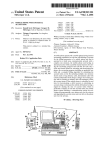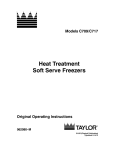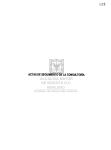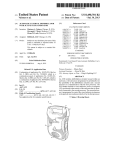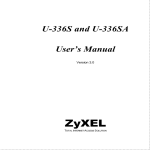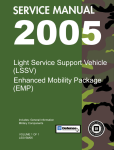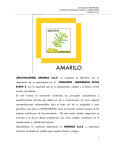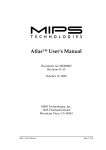Download System, method and mobile device for remote control of a voice mail
Transcript
US008498289B2
(12) United States Patent
(10) Patent N0.:
(45) Date of Patent:
Castell et a].
(54)
SYSTEM, METHOD AND MOBILE DEVICE
FOR REMOTE CONTROL OF A VOICE MAIL
SYSTEM
(56)
U.S. PATENT DOCUMENTS
4,106,060 A
8/1978 Chapman, Jr.
4,417,349 A
4,558,454 A
Gary P. Mousseau, Waterloo (CA);
Mihal Lazaridis, Waterloo (CA)
Notice:
4,644,351 A
Subject to any disclaimer, the term of this
patent is extended or adjusted under 35
11/1983 Hills et al.
12/1985 Hills et al.
2/1987 Zabarsky et a1.
(Continued)
FOREIGN PATENT DOCUMENTS
AU
DE
7843498
19961345
5/1997
12/1999
(Continued)
U.S.C. 154(b) by 1469 days.
OTHER PUBLICATIONS
This patent is subject to a terminal dis
claimer.
Feibus, “A Desktop in Your Palm”, Informationweek, Aug. 25, 1997,
pp. 65ff.
(21) Appl. No.: 11/857,560
(22) Filed:
*Jul. 30, 2013
References Cited
(75) Inventors: William D. Castell, Waterloo (CA);
(73) Assignee: Research In Motion Limited, Waterloo
(CA)
US 8,498,289 B2
(Continued)
Sep. 19, 2007
Primary Examiner * Asad NaWaZ
Assistant Examiner * Nicholas Jensen
(65)
Prior Publication Data
US 2008/0008163 A1
(74) Attorney, Agent, or Firm * Jones Day
Jan. 10, 2008
(57)
Related U.S. Application Data
(63)
Continuation of application No. 10/051,697, ?led on
Jan. 18, 2002, noW Pat. No. 7,283,808.
(60)
Provisional application No. 60/262,575, ?led on Jan.
18, 2001.
(51)
(52)
(58)
ABSTRACT
A uni?ed messaging system, method and user interface is
provided for a handheld mobile communication device. The
method may include the following steps: (a) receiving a noti
?cation signal at the Wireless device via the Wireless data
channel indicating that the uni?ed messaging system received
and stored a voice mail message intended for a user of the
Wireless device; (b) transmitting a command signal from the
Wireless device to the uni?ed messaging system via the Wire
less data channel, the command signal including a message
Int. Cl.
H04L 12/66
(2006.01)
H04M1/64
(2006.01)
retrieval command; (c) receiving via the Wireless voice chan
USPC .................... .. 370/352; 379/8811; 379/8817
nel a voice call initiated by a voice mail system component of
the uni?ed messaging system in response to the message
retrieval command transmitted from the Wireless device; and
(d) receiving the voice mail message from the uni?ed mes
Field of Classi?cation Search
saging system via the Wireless voice channel.
U.S. Cl.
USPC ................... .. 370/352; 379/8811, 88.17, 352
See application ?le for complete search history.
17 Claims, 10 Drawing Sheets
Corporate Ofiice or ASP Of?ce or Network Carrier
Web Interface ‘ Uni?ed Messaging
Sub-system
E-Maii Interface
125 me
Telephone
9
1:
1|
.
135
/
lntemet
/
I
,
/Wireiess
Network
1503
Wireless
Network
,
Notification
Talk...
INGOMING CALL - HELD
Calier Id: 5551212
Matching Name ITOm Smith
ACTION TO BE TAKEN:
21 Min)
,_
Dual»Mode
Mobile
Device
1.2 Mm) i100
")
(1 Min)
in)
US 8,498,289 B2
Page2
U.S. PATENT DOCUMENTS
4,695,880 A
9/1987 Johnson etal.
4697281 A
9/1987 USulHvan
4,713,780 A
5,758,150 A
5’761’416 A
5,764,639 A
12/1987 Schultz etal
4’768’087 A
8/l988 T b
l
'
5/1998 Bell et :11.
6/1998 Mandal etal'
6/1998 Staplesetal.
5’764’899 A
6/1998 Egg-“ton etal'
5,765,170 A
6/1998 Morlkawa
4,837,798 A
M989 (£15351
5,771,353 A
6/1998 Egglestonetal.
4,837,800 A
4,845,658 A
6/1989 Freeburg etal.
7/1989 Gifford
288888?
A
’
’
38882 231133“
.
4856 047 A
M989 Saunders
5,790,790 A
8/1998 Sm1thet_a1_.
4,928,096 A
5/1990 Leonardo etal.
28888;? A
88882 g‘g'irsmizlm
8/1990 Nelson etal.
O’Sullivan
1
5’812’773 A
5,812,819 A
9,1998 Nom’l '
9/1998 Rodwlnetal.
M991 Mlth it”
M991 Milsyol
5,813,016 A
5,819,172 A
9/1998 Sumimoto
10/1998 Campana,Jr.etal.
5’819’284 A
10/1998 Father 8t 31'
4,951,044 A
4,972,457 A
4980907 A
5,008,926 A
5,043,721 A
5,068,916 A
11/1990
11/1991 Harrison etal.
5086 502 A
2/l992 M31
5,125,021 A
5,127,041 A
M992 Lb“)?
M992 o‘fsf?‘l’ilvin
’
’
0/1990 Ra.h
1
r
A
8888; ggguaénoto etal'
’
5,822,434 A
10/1998 Caronnletal.
5,826,062 A
5,838,252 A
10/1998 Fake,Jr.eta1.
11/1998 Kikinis
5,838,926 A
11/1998 Yamagishi
5,844,969 A
12/1998 Goldman etal.
58888 5820mm
5,157,660 A
10/1992 Knwahara etal.
2828333 A
5,159,592 A
10/1992 Perkins
5’862’32l A
5,177,680 A
1/1993
5181200 A
M993 H
5,210,785 A
“993 83:12:’;
A
5,272,754 A
5283 887 A
12/1993
Tsukino etal.
’
.
Boerben ..................... .. 713/159
M994 Z h
in etal
-
g
'
2/1999 Schmldtetal.
5,878,434 A
3/1999 Drapereial.
283583122
71222 21:11,,
5,903,723 A
5/1999 Becketal.
5,905,777 A
5/1999 Foladareetal.
’
’
'
5,293,250 A
M994 of ery
5,299,255 A
M994 lwalugggfw
5,917,629 A
6/1999 Honensinseial.
5,313,582 A
5/1994 Hendeletal.
5928329 A
7/ 1999 Clark- et a1‘
5315 635 A
571994 K
1
5,937,161 A
8/1999 Mulllganetal.
5,333,152 A
5,333,266 A
M994 W?fet”
M994 Béazeztal
5,941,956 A
5,943,426 A
8/1999 Shirakiharaetal.
8/1999 Frithetal.
5,370,566 A
1
1,1999 L
’
5,867,660 A
2828888 A
88888 2358:“ et 31'
5,392,390 A
5,406,557 A
5,410,543 A
2/1995 Crozier
4/1995 Baudoin
4/1995 Seitzetal.
5’953’322 A
5958806 A
5’96l’590 A
9,1999 Kimball
9,1999 E 1 t
M
“M999 Niggjsontzl '
5,416,473 A
5,416,842 A
5/1995 Du1aney,IIIeta1.
5/1995 Fleming/HI
5’964’833 A
5,966,663 A
“M999 Kiirilnfsze
10/1999 Gleason
5,436,960 A
7/1995 Campana, Jr. et a1.
5,452,356 A
9/l995 A???“ Let
5’479’472 A
0/1995 canipana Jr etal
5438611 A
5,481,611 A
5487100 A
5,491,739 A
5493 692 A
5,495,484 A
12/1994 Mitchell, Jr. etal.
8/1995 C
J
31
~
1/1996 Owens etal.
M996 Kane
2/1996 Wadin etal. ............... .. 340/721
2/1996 Theimeretal
M996 S If
1
~
5,548,789 A
8/19% Niketa'
5,559,800 A
9/l996 M mum
’
’
'
5,968,131 A
10/1999 Mendezetal.
5,973,612 A
10/1999 Deoetal.
5,974,180 A
10/1999 Schwendeman
5’974’238 A
5,978,837 A
10/1999 ChaSe’Jr'
11/1999 Foladareetal.
5983973 A
5987508 A
5,995,597 A
181999 Dltzghk
1
111999 Agr mm eta‘
11/1999 Woltzetal.
6,000,000 A
12/1999 Hawkinsetal.
31
6,006,274 A
12/1999 Hawkinsetal.
5,572,528 A
11/1996 shilejiseauet '
6’009’173 A
12/1999 Sumner
5,579,472 A
11/1996 KeyW01th,IIeta1.
8818288 A
85888 835mg“ 31'
5,588,009 A
12/1996 Will
6’0l8’762 A
1,2000 BC In‘
5,598,536 A
5,603,054 A
1/1997 Slaughter, 111 et al.
2/1997
Theimer et a1.
6’023’700 A
’
’
455/518
"tm'l """""""" "
20000 0811213122213‘
'
5 604 788 A
M997 T A
6,023,708 A
2/2000 Mendezetal.
5,625,670 A
41997 czmpana Jr etal
6,029,149 A
2/2000 Dykstra etal. ................ .. 705/38
5,627,829 A
5,630,060
5/1997 Tang
Gleeson
etal'eial.
6,052,442
888288}, A
4/2000
88888 Cooper etal.
5,631,946 A
5/1997 Campana, Jr. etal.
6’052’563 A
40000 Macko
5,633,810 A
5/1997
Mandal etal.
’
’
-
5638 450 A
M997 R b
6,052,735 A
4/2000 Ulrlch etal.
5,666,530 A
9/l997 ci’ariogtal
6,058,431 A
5/2000 srisnresheial.
9/1997 Crozier
@675“ A
5/2000 D1119“
9/l997 P
6,072,862 A
6/2000 SrlnlVasan
6,073,137 A
6,073,165 A
6,084,969 A
6/2000 Brownetal.
6/2000 Narasimhanetal.
7/2000 Wrightetal.
7/2000 Mendez etal.
5,666,553 A
5673 322 A
5,701,423 A
5,706,211 A
5’727’202 A
t 1
0/1997 CGPGP a'
M998 Br‘l’ztlfirt 1
M998 Kiceaize 3'
5’729’735 A
3,1998 Me Grin
6,085,192 A
5’737’531 A
M998 Ehlzy g
6,085,231 A
7/2000 Agraharametal.
5,742,905 A
4/1998 Pepe etal.
6,085,232 A
7/2000 Klkln?
5,745,689
5,751,960
5,751,971
5,754,954
5,757,901
4/1998
5/199g
5/1998
5/1998
5/1998
6,091,951
6,092,114
6,092,191
6,101,531
6,112,244
7/2000
7/2000
7/2000
8/2000
8/2000
A
A
A
A
A
5,758,088 A
yeageretal‘
Matsunaga
Dobbins etal.
Cannon etal.
Hiroshige
5/1998 Bezaire et a1.
A
A
A
A
A
6,115,394 A
Sturnlolo etal.
Shafferet a1.
Shimbo etal.
Eggleston et 31.
Moore etal.
9/2000 Balachandran et a1.
US 8,498,289 B2
Page 3
6,115,736
6,125,281
6,125,369
6,128,739
6,130,892
6,131,096
6,131,116
6,134,432
6,138,146
6,141,690
6,144,671
6,144,997
6,151,606
6,154,839
6,157,630
6,157,950
A
A
A
A
A
A
A
A
A
A
A
A
A
A
A
A
9/2000
9/2000
9/2000
10/2000
10/2000
10/2000
10/2000
10/2000
10/2000
10/2000
11/2000
11/2000
11/2000
11/2000
12/2000
12/2000
Devarakonda et al.
Wells et al.
Wu et al.
Fleming, III
Short et al.
Ng et al.
Riggins et al.
Holmes et al.
Moon et al.
Weiman
Perinpanathan et al.
Lamming et al.
Mendez
Arrow et al.
Adler et al.
Krishman
WO
WO
WO
WO
WO
WO
WO
WO
WO
WO
WO
WO
WO
WO
WO
WO
9800787
9821911
9823108
9826344
9848560
9905620
9905813
9906900
9912365
9917505
9919988
9936870
9945484
9945684
9948312
9950974
1/1998
5/1998
5/1998
6/1998
10/1998
2/1999
2/1999
2/1999
3/1999
4/1999
4/1999
7/1999
9/1999
9/1999
9/1999
10/1999
6,163,274 A
12/2000 Lindgren
WO
9963709
12/1999
6,167,379 A
6,170,057 B1
6,185,603 B1
12/2000 Dean et al.
1/2001 Inoue et al.
2/2001 Henderson et al.
WO
WO
WO
0011567
0011832
0020994
3/2000
3/2000
4/2000
6,215,859 B1*
4/2001
WO
0113572
2/2001
6,219,694 B1
4/2001 Lazaridis et al.
WO
0113656
2/2001
6,233,341 B1
6,240,088 B1
6,249,820 B1
5/2001 Riggins
5/2001 Gayton et al.
6/2001 Dobbins et al.
WO
WO
WO
0141472
0167716
0171539
6/2001
9/2001
9/2001
6,256,666 B1
6,272,545 B1
7/2001 Singhal
8/2001 Flanagin etal.
6,275,848 B1
8/2001
6,275,850 B1
g/ZOOI Beyda et a1‘
6,292,668 B1
6,314,519 B1
6,324,544 B1
6,324,587 B1
Hanson .................... .. 379/8822
OTHER PUBLICATIONS
Arnold
9/2001 Alanara et al.
_
_
Behr, “Handheld Solutrons”, Informatronweek, Oct. 27, 1997, pp.
106-113.
11/2001 Davis et a1~
11/2001 Alan‘ et a1~
Moody’s Investors Service, Socket Communications Inc.iHistory
& Debt, Investex Report No. 3240276, Feb. 28, 1998.
11/2001 Trenbeath et al.
Newsletter E_Mail Mer
6,330,244 B1
12/2001
SwartZ et al.
6,333,973 B1 4
12/2001 Smith et a1, ,,,,,,,,,,,,,, H 379/8812
_
_
’
ges
W.th V .
‘_
(“Ce
Th
mug
h I ? .t T h
n n‘ e
l _
ec no 0
gles, Volce Technology & Servwes News, May 26, 1998'
6,356,956 B1
6,389,115 B1
6,389,276 B1
3/2002 Deo et 31,
5/2002 Swistock
5/2002 Brilla et al.
6,400,958 B1
6/2002 lsomursu et 31'
Mosher, Microsoft Exchange User’s Handbook, Duke Press, 1997,
6,408,177 B1
6/2002 Parrkh et al.
pp‘ 547649
6,434,378 B1
8/2002
6,449,287 B1
6,580,784
6,636,733
6,792,086
2001/0001552
2001/0015977
2001/0029531
B2
B1
B1
A1
A1
A1
Fougnies
Newsletter, VODAPAGE: Vodapage demos increasing convergence
of pagers and mobile communications at TMA 29, M2 Presswire,
Nov, 28, 1996,
-
-
-
9/2002 Leuca et a1‘
3D(;l"Sl;7\9/17reless Websrte located at D.R.L. www.dtsw1reless.com, Dec.
533123211"
“3Com PalmPilot Gets Wireless Link for E-Mail”, Spooner, John G.,
Rodriguez etal.
Helferich
Saylor et al.
Vong et al.
Johansson
Ohm
PC Week, De°~ 8, 1997~
“Have Your Pager Call My Pager”, Sullivan, Kristina B., PC Week,
Dec. 8, 1997.
Briere, Daniel, et al., “One Mailbox, Just Like Old Times,” Network
World, vol. 14, issue 16, p. 21 (Apr. 21, 1997).
Padwick, et al., Special Edition Using Microsoft Outlook 97, 1997,
6/2003
10/2003
9/2004
5/2001
8/2001
10/2001
2001/0040693 A1
11/2001 Sai-to-et al.
Que Corporation, pp‘ 250-251, 353-367,
2001/0042093 A1
11/2001 Shlral et a1~
News Release, “Motorola Rings in 1995 with the Launch of the
2001/0048676 A1 * 12/2001 Jlmenez et al' """"""" " 370/352
Marco® Wireless Communicator,” Jan. 4, 1995 (4 pgs.).
2001/0054072 A1 12/2001 D_1S_cf)l° et 31'
2002/0059380 A1
5/2002 Blhns et 31'
FOREIGN PATENT DOCUMENTS
Timeline, “FLEXTM Technology Timeline,” (3 pgs.), Jun. 18, 2001.
General Magic, Inc., Corporate Backgrounder, 2001 (2 pgs.).
Pegasus Email Settings, ABSnet Internet Services, Inc. (4 pgs.),
2001.
EP
0617373
9/1994
EP
0736989
10/1996
EP
0772327
5/1997
Motorola, Inc., emailVClient, 2001 (4 pages).
News Release, “Motorola Announces Pagewriter 250, The World’s
.
2,
EP
EP
0777394
0788287
6/l997
8/1997
Smallest Pager w1th Full Keyboard , Feb. 27, 1997 (2 pgs.).
Dewey, Barney, “Communrcatrons Strategres for Newton 2.0,”
EP
Ep
EP
0793387
0825788
9/1997
2/199g
Newton
Press Release, “Motorola
Journal,
Announces New Solutions to Provide Con
sumers with Wireless Access to Personal and Enterprise E-mail
EP
0838934
4/1998
Accounts,” Mar. 21, 2001 (4 pgs.).
EP
0772327
2/ 1999
“Motorola’s ‘Marco’ Wireless Communicator, ” www.msu.edu/
EP
0838774
4/1999
luckie/gallery/marcohtm, Jun. 14, 2001 (3 pgs.).
News Release, “CE Software Announces MobileVision,” Editorial
EP
0918417
5/1999
EP
0930766
7/1999
i?
Contacts, CE Software, Inc., 1995 (3 pgs.).
Eggs Release, “CE Software Ships Mobile Vision,” Jun. 20, 1995 (3
$8
Newton Reference, Communications, 1996-1997(4 pgs.).
W0
9727717
7/1997
PC Pro Issue 31: Realworld Computing, PDA Column, Jul. 30, 1997
WO
9732251
9/1997
(7 PgS~)~
WO
9733421
9 /1 997
WO
WO
9741654
9744942
11/1997
11/1997
Enterprise
Solutions
for
Email
Overload,
Founder
Publications,www.amikanow.com/corporte/publications.htrn, Aug.
6,2001 (9 pgs.).
US 8,498,289 B2
Page 4
“Motorola’s ‘Marco’ Wireless Communicator,” www.msu.edu/
luckie/gallery/marcohtm, Aug. 6, 2001 (2 pgs.).
Press Release, “Apple Agrees to License Newton Technology to
Schlumberger, Digital Ocean,” Nov. 3, 1995 (3 pgs.).
FreZZa, Bill, “PDA, PDA, Wherefore Art Thou, PDA?”, Freewire,
Aug. 6, 2001 (6 pgs.).
Black, Lauren, et al., “Personal Digital Assistants,” Macworld
Reviews, Aug. 6, 2001 (5 pgs.).
Reference, “MobileVision Direct Wireless Connection to Your LAN
Based Electronic Mailbox,” CE Software, Inc., pp. 1, 3, 5, 7, 9, 11, 13,
15,17,19,21,1995.
User Manual, “Mobile Vision Direct Wireless Connection to Your
LAN-Based Electronic Mailbox,” CE Software, Inc. 1995.
Johnson, David B., “Ubiquitous Mobile Host Internetworking,”
Fourth Workshop on Workstation Operating Systems, pp. 85-90, Oct.
14-15, 1993.
Johnson, David B., “Mobile Host Internetworking Using IP Loose
Source Routing,” School of Computer Science, Carnegie Mellon
Claxton, “Messaging API’s for Voice Networks,” Telecommunica
tions, pp. 116-120, 1998.
Gifford, David K., et al., “The Application of Digital Broadcast
Communication to Large Scale Information Systems.” IEEE Journal
on Selected Areas in Communications, vol. SAC-3, No. 3, pp. 457
467 (May 1985).
Gifford, David K., et al., “An Architecture for Large Scale Informa
tion Systems,” ACM, pp. 161-170 (1985).
SAM Reference Manual, System for Automated Messages (Sep.
1989).
IBM Portable Terminal User’s Guide, Third Edition (Jun. 1985).
Binder, Richard et al, The Alohanet Menehune, University of Hawaii,
Version II (Sep. 1974).
Computer StructuresiPrinciples and Examples, McGraw Hill
(1982).
Krebs, Jay, Portable Computer and Host Talk Over Radio-Frequency
Link, Electronic, pp. 142-145 (Aug. 25, 1983.
University, pp. 1-14 Feb. 1993.
Schoettle, Bob, “IP-Address Management on LANs,” Byte, pp. 199
200, Feb. 1996.
Gadol, Steve, et a1. “Nomadic TenetsiA User’s Perspective,” Sun
Cheshire, Stuart, et al., “Internet Mobility 4 X 4,” Computer Science
Department, Stanford University, pp. 1-12, Aug. 1996.
Yeom, HoenY, et al., “IP Mutliplexing by Transparent Port-Address
Translator,” Proceedings of the Tenth USENIX System Administra
tion Conference, pp. 113-122, Sep. 29-Oct. 4, 1996.
Johnson, David B., “Scalable and Robust Internetwork Routing for
Mobile Hosts,” IEEE Computer Society, pp. 2-11, 1994.
(Sep. 3, 2002).
Egevang, K. et al., “The IP Network Address Translator,” Network
Working Group, pp. 1-10, May 1994.
Microsystems Laboratories, Inc., pp. 1-16 (Jun. 1994).
Declaration of David A. Keeney regarding SAM System, pp. 1-33
“SAM TM integrates E-mail, Alpha Paging, Fax, and more!”, SAM
System for Automated Messages (10 pgs.).
SAMpage Manual, version 2.0, TeckNow! (Feb. 1990).
Reiter, Alan A., “Focus on Technology,” Telocator (Jan. 1990) (4
pgs)
Kuehn, Carl, “More than EMail,” Southwest Computer & Business
Equipment Review, vol. VII, No. 2, (Feb. 1990) (1 pg.).
SAM System for Automated Messages User’s Manual (1988) (17
Manual, “Server and BBS Software for the Packet Radio” by Jean
Paul Roubelat, pp. 1-173, 1993.
pgs)
Book, “Internetwork Mobility The CDPD Approach,” by Mark S.
Taylor, William Waung, and Mohsen Banan, Jun. 11, 1996.
“BlackBerry Technical White Paper,” Research in Motion Ltd., Ver
play Radio Pagers Personal Message Center (2000) (7 pgs.).
sion 1.0, 1998-1999.
Newsletter, “Battery Friendly Bulletin,” vol. 1, Issue 3, pp. 1-7 and
unnumbered page, 1999.
Article, Comerford, “Handhelds Duke It Out for the Internet,” Wire
less Internet, pp. 35-38 and 41, Aug. 2000.
Press Detail, “Extended Systems and Motorola Bring Short-Range
Wireless to the Paging E-volution,” Jan. 13, 2000 (3 pgs.).
Press Detail, “3Com Corporation Licenses Bluetooth Technology
from Extended Systems,” Feb. 22, 2000 (2 pgs.).
Motorola Operating Instructions for Your “PMR 2000” Series Dis
Motorola PMR 2000 Personal Message Receiver POCSAG (CCIR
Radio Paging Code #1) (1986) (6 pgs.).
Undated, Information Display Pager D40, NEC Corporation (6 pgs.).
Motorola, “AirMobileTM Wireless Comm Guide for cczMail” User
Guide Version 1.0, Motorola Wireless Data Group, 1995, pp. 3-48.
Motorola, “AirMobileTM Wireless Comm Server for cczMail” User
Guide Version 1.1, Motorola Wireless Data Group, 1995, pp. 4-46.
Sun Microsystems, JavaMail API Design Speci?cation, Version 1.0,
Dec. 9, 1997, Sun Microsystems, Inc., chapters 1-10 appendicesA-E.
Compaq, Aero 2100 Series Color Palm-size PC Reference Guide,
Second Edition, Aug. 1999, Compaq Corporation.
Web site Article, Hawaleshka, “The Web inYour Pocket,” Maclean’ s,
May 15, 2000 (3 pgs.).
* cited by examiner
US. Patent
Jul. 30, 2013
US 8,498,289 B2
Sheet 1 0f 10
110b
115a
110a
W
,
E'Ma'l
Corporate
Services
140D
I
/
Messaging
Server
140a
105b
105a
Portal
Services
Phone
Services
I
1
Internet
Services
T
M
v
Uni?ed
essaging
.
Services
Corporate
125
140c
Phone Services
\
115b
ASP/ISP Location (B)
120
Firewall
Corporate Location (A)
Firewall
105O~___
145a
/
Interface
bz??ed
145k,
Services
Messaging
|
Sen/ices
|
Services
.
Internet
115c H
155\
100
H
Network Backboné
g
Phone Services
!
& Voice Mail
Dual-Mode
MObHe
‘
Network Carrier Location (C)
Device
‘VL
FIG. 1
l
145C
Traditional
Voice Calls
US. Patent
Jul. 30, 2013
Sheet 2 0f 10
US 8,498,289 B2
Corporate Office or ASP Office or Network Carrier
W103 m.
Uni?edSub-system
Messaging
— \ \
Server/ "5 _*E-Ma|| Interface
Notes)
PBX &VoiceMail
110a
205
22
Interface
\
\
21%
/115
\
3 — — — ~ —
_
-
IF-__IO
pill 220 210C
4_F.>_B>isystem
:‘Dwith'Voice
'
ail
'——— 235 (Outside
Resources - T1,
lSDN, PSTN, etc)
150a
Unified
Event --EFebruary
Rcv 08:0Oa
15 Joe Blow Lets Do a Deal... Come and Talk...
Listin
t Rcv 09:00a Joe's Boss Outgoing Call: # 545-2345 (21 Min)
g E Snt 09:10a E-Mail Friend Of?ce Party Next Week...
Dual'gllode
0 _' e
Device
(Exchange, L_________~___—_l_\
\\g /
‘1 Vm 10:00a Voice Mail, Caller Id: 555-1212 Ref #3 (1.2 Min) —— 100
313 Rcv11z00a Person Y incoming Call & Memo (10 Min)
C _Vm 12:05p Voice Mail, Caller Id: 999-9899 Ref #12 (1 Min)
Snt 2:00p Conference Call - Command Used (30 Min)
E Snt 4:00p Person A Called from e-mail (30 Min)
240
-- February 14 -
FIG. 2
US. Patent
Jul. 30, 2013
US 8,498,289 B2
Sheet 3 0f 10
Corporate Office or ASP Office or Network Carrier
i Web Interface
\ Uni?ed Messaging
\\
l E-Mall Interface ~ \
Sub-system
\
PBX & Voice
Mail Interface
1, __
125
Telephone
:|
\/
|I
"'1
Incoming Q ||'— 235
230/ Calls
135
Internet
- |
Call Back
150a
Unified -- February 15 -Event EEI Rcv 08:00a Joe Blow Lets Do a Deal... Come and Talk...
Listing
Dual-Mode
Mobile
C Rcv 09:00a Joe's Boss Outgoing Call: # 545-2345 (21 Min)
Device
E Snt 09:10a E-Mail Friend Office Party Next Week...
c Vm 10:00a Voice Mail, Caller Id: 555-1212 Ref #3 (1.2 Min) -—1OO
SIS Rcv11zOOa Person Y Incoming Call & Memo (10 Min)
C Vm 12:05p Voice Mail, Caller Id: 999-9899 Ref #12 (1 Min)
@Snt 2:00p Conference Call - Command Used (30 Min)
E Snt 4:00p Person A Called from e-mall (30 Min)
250
-- February 14 -
FIG. 3
US. Patent
Jul. 30, 2013
Sheet 4 0f 10
US 8,498,289 B2
Opening an Item in the
Event Listing Screen
"59
February
Rev 08:0Oa""
Joe Blow Lets Do a Deal...
Cmse Men“
M b.|
C Rcv 09:00a Joe's Boss Outgoing Call: # 5 Open Item
E Snt 09:10a E-Mail Friend Office Partv N Delete Item
|>
0 _' e
Devlce
—— 100
C Vrn 100% Voice Mail Caller Id‘ 55542‘ Sort List
‘IS Rcv11:0Oa Person
Incoming Call & Me Find A" -Vm
C Vm 12:05p Voice Mail, Caller Id: 999-989 File Item
E] Snt 2:00p Conference Call - Command
_
E Snt 4:00p Person A Called from e-mail opt'ons
-- February 14 --
255
FIG. 48
Voice Mail Message -
Choice Screen
" FeL
' FVOICE MAIL MESSAGE - Ref# 3
5?
Caller Id: 555-1212
E
Matching Name: Tom Smith
.
Call Length: 1.2 Minutes
c
E
Play or
D I
-- F UUUU ...,
Dual-Mode
218M.“
Call Time: Mon. Feb. 15 -10:0Oa
ACTION TO BE TAKEN:
6]
‘T k
Mobne
In)
D evice
1 2 Min) __ 100
'
1")
.
i/|€1)Mm)
'n
.1
FIG. 4b
260
Voice Mail
DTMF Interface
l
D
I M d
_
J l
Voice Mail Interface Actions
_
0
Mobne
v
CFFWDJ < Stop > 1)I
Device
E‘C k Play ) I Rewind)
100
\TE l Pause ) I Replay I ( Delete ) @ I?) —
n
@
__
l
Next
\
Previous I
t
First
\
Last
)
Status: Playlng Message #3 <caller |d>\
FIG. 4c
\ 265
e
US. Patent
Jul. 30, 2013
Sheet 6 0f 10
US 8,498,289 B2
Corporate Office or ASP Office or Network Carrier
Web Interface
‘
Messaging
Sub-system
E E-Mail Interface
l
PBX & Voice
!
Mail Interface
PBX SysteTn
225
c
120
with Voice
@_ _ _ Mai
H
I
(,
~q_ \
|
Firewall
ll
|I-— 235
5".
Internet
\ \
| <- -' '—'/_='J|
Outgoing Calls/ /
/ | I
/
I
'
Conference
/
I
270
150a
Conference Call
Interface
..
Fnhrnaru 1R
E
E
g
_
Dual-Mode
Conference Call Setup Screen
P
_
_
_
artlclpants. Tom Jones, Joe Blow,
Blair Witch
Suspend
FIG. 6
Add
Mobile
Device
)_1OO
Remove \\
US. Patent
Jul. 30, 2013
US 8,498,289 B2
Sheet 7 0f 10
Corporate Office or ASP Office or Network Carrier
if
Uni?ed Messaging
Web Interface
Sub-system
I E-Mail Interface
2100
PBX & Voice
Mail Interface
I...
I
120—
L15
41)‘
220
PBX System | I
with Voice Maill|
H
c
l h,
V-Mail
||
225
Dropped
Firewall
/
230
1502
Notification
Event -- Februarv 15
150b
--
Dual-Mode
.
21 Min)
Mobile
Device
lTalk...
INCOMING CALL - HELD
280\
Caller Id: 555-1212
Matching Name : Tom Smith
ACTION TO BE TAKEN:
....
FIG.
(1.2 Min) ——100
n)
z (1 Min)
vlin)
US. Patent
Jul. 30, 2013
Sheet 8 0f 10
Voice-mail
US 8,498,289 B2
PBX System
recorded and
<
saved as usualJ
:
voice-mail
'
+
A can is
sends call to
received
I
i
I
404
400
402
Voice mail system sends —406
summary of call details to
PBX/Voice-Mail Interface
416
4T8
l
408
Device notifies1
Does User
Ha e a Mom
V
User Re.spondg by
user ofincoming —> . openmg Ian
message
issuing a p ay or
' 6
connect
Device?
A
412
414
|
Message Placed into I
Unified Message System
Storage area
I _
420
ugmetd Message
:
I R ‘7
ys em Sen 5
esponse
summary message to
message prepared
mobile device
and sent
424
428
_
462 l
‘Command recognized
Othel
Want 3 Wm‘
Processing
ma" message’;
Mes.sage
and given to the PBX/ <-
voice_mail imerface
recev'ed by
Unified
message server
430
Yes
I
436
432
ll
-
PBX/voice-mail
component executes
ls message
the command
448
452
/i Drop Call
number
442l
Use default
number
l
I
450
4'44
PBX/voice-mail interface
calls the dual mode mobile
Process all DTMF / device using the provided
Commands
FIG. 8
# and plays the message
US. Patent
Jul. 30, 2013
mobile device sends
Sheet 9 0f 10
Unified Messaging Server
US 8,498,289 B2
PBX/voice-mail interface
message to unified » sends message to the —> extracts all phone numbers
messaging server
PBX/voice-mail interface
for conference call
'
I
500
502
Clear call; cancel
Corn leted
Okay?
510
request with phone #s
'
508
506
512_'PBX system instructed to
make phone cells out
through phone circuits
514——
.
timer
started for
.
System waits
for
competed circuits
516__ call completions
L
Call Answered by
Timer Expires (may
526_ be lengthened)
attendee, timer
518——~ lengthened 'once‘
PBX plays message
528
52O—' to new conference
attendee, call bridged
At least one cal
completed?
Yes
into conference
52
Clear call; cancel
conference
I
Conference Yes
I Continues
l
l
530
524
l
504
PBX/voice-mail interface
informs PBX system of user
Organizer Ca
T‘ Conference
l
a5_t Ca" t_° be
bridged Into
call?
FIG. 9
US. Patent
Jul. 30, 2013
Sheet 10 0f 10
Call received by
US 8,498,289 B2
Yes
PBX system
-
T
602
600
NO
604
Call detected by PBX/
606 _
voice-mail interface
610
612
Call sent to
voice mail
does user
have a
PBX requested to hold
call, please hold
system
device?
message is played
608
PBX forwards held call
634*” to number provided,
614 __ summary Of call sent to
sends to voice-mail or
hangs up the Caner
uni?ed messaging system
r
—
6'18 ,
.f d
632 “—
.
uni |e messaging system
delivers message to mobile
device
Start timer for
f
What to do with Ca"
T
voice-mail interface
612 {I
6 4
PBX/voice-mail
interface instructs PBX
630—_command given to PBX/
Call
Timer expires
M
?
User Acts on
the message?
v
call sent to voice
mail system
FIG. 10
Call Processing
command sent back to
uni?ed messaging system
US 8,498,289 B2
1
2
SYSTEM, METHOD AND MOBILE DEVICE
FOR REMOTE CONTROL OF A VOICE MAIL
SYSTEM
and stored a voice mail message intended for a user of the
Wireless device; (b) transmitting a command signal from the
Wireless device to the uni?ed messaging system via the Wire
less data channel, the command signal including a message
retrieval command; (c) receiving via the Wireless voice chan
CROSS REFERENCE TO RELATED
APPLICATION
nel a voice call initiated by a voice mail system component of
the uni?ed messaging system in response to the message
retrieval command transmitted from the Wireless device; and
(d) receiving the voice mail message from the uni?ed mes
This application is a continuation of US. application Ser.
No. 10/051,697 ?led on Jan. 18, 2002, now US. Pat. No.
saging system via the Wireless voice channel.
7,283,808 B2.
This application also claims priorty from US. Provisional
BRIEF DESCRIPTION OF THE DRAWINGS
Application Ser. No. 60/262,575 ?led on Jan. 18, 2001. Both
of these prior application are hereby Incorporated be refer
FIG. 1 is an overvieW of Where the invention is used in three
different environments Where PBX and voice-mail systems
ence into this application.
BACKGROUND
1. Field of the Invention
The present invention is directed toWard remote control of
a host system With a dual-mode mobile communications
20
device (mobile device). Speci?cally a method is disclosed for
can reside;
FIG. 2 shoWs one embodiment of the invention as used by
a mobile device user to retrieve voice mail;
FIG. 3 shoWs a second embodiment of the invention as used
by a mobile device user to retrieve voice mail;
FIGS. 4a, 4b and 4c are examples of three control screens
seamlessly integrating PBX services, including voice mail
seen by the user of the mobile device When they interact With
services, into a mobile device for control by the user.
the uni?ed messaging system;
2. Description of the Related Art
There are very feW systems that alloW remote control of
host systems from mobile devices. There are no knoWn solu
tions that use a dual-mode mobile device to remotely control
PBX and voice mail systems. In the area of related art the
FIG. 5 is an overvieW of a Wireless dual-mode device
25
FIG. 6 is an illustration of hoW conference call is estab
lished using the mobile device as the conference call initiator;
closest solution knoWn to the author uses a broWser-like
method for controlling ?le vieWing, ?le printing and ?le
30
re-routing like to a fax machine. Some of these solutions can
also act like a terminal emulator and thus alloW the user to
lo gin to the company netWork and act like any other terminal
user. These types of solutions are very far from What is
described in this patent. In the ?eld of phone technology there
shoWing all the major hardWare components in the system;
FIG. 7 is an illustration of hoW an incoming call can be held
and controlled by the user of a mobile device;
FIG. 8 is a data How diagram shoWing the steps necessary
to request a voice-mail message by sending a data message to
a uni?ed messaging server;
FIG. 9 is a data How diagram shoWing the steps necessary
to set up a conference call via a data message sent to a uni?ed
35
messaging server; and,
are also methods to call a service provider and turn call
FIG. 10 is a data How diagram shoWing the steps necessary
forwarding on or off, and change the call forWarding number.
to process a held call via a data message sent to a uni?ed
In this area an individual home phone, of?ce phone, or cell
messaging server.
phone can adjust some of the operating parameters but this
has no multi-discipline effect on both voice and data infor
mation.
It is naturally possible to use tWo devices to perform some
of the actions described in this patent, but these solutions have
lots of problems and are prone to errors. For example one
device is inevitably turned off, or has out of battery, or is out
of reach in a suitcase or a travel bag. The elegance of having
full control over the PBX and voice system is the ideal solu
tion. There is also the problem of costs for all these devices to
solve problems of data and voice noti?cations. By adding
costs and requiring multiple devices to solve simple problems
40
DETAILED DESCRIPTION
A. OvervieW of the System
With reference to FIG. 1 this diagram provides an overvieW
45
to the environment Where the invention is used. The ?rst
component in the illustration is a dual-mode mobile device
100 (“mobile device”). This mobile device 100 is shoWn as
having Radio Frequency (“RF”) connections to both a data
Centric Wireless netWork 150a and a voice-Centric Wireless
50
network 1501). The voice-centric network 150!) preferably
provides circuit sWitched communication connections.
the number of users Will to purchase such a solution goes
Although these netWorks are shoWn as separate, one skilled in
doWn very quickly. Finally, there is a complete lack of
the art Will appreciate that it is noW possible for a single
netWork like GSM/GPRS to support both cell phone and data
elegance When tWo devices are required to deal With both
voice and data to proper control over the host system. The
mobile user expects simplicity and ease of use When deal With
traf?c through the same netWork infrastructure. Another com
55
noti?cations, and acting upon noti?cations.
Therefore, there remains an important area of remote con
trol of a host system, from a dual-mode mobile communica
bility to Wireless mobile devices has not proceeded due to a
lack of integration of functionality in the mobile device. In
tion device, that has not been satis?ed.
60
Provider (ASP) or Internet Service Provider (ISP) environ
ment (B), or Within the Wireless netWork carrier location (C).
A uni?ed messaging system, method and user interface is
provided for a handheld mobile communication device. The
?cation signal at the Wireless device via the Wireless data
channel indicating that the uni?ed messaging system received
this context the uni?ed messaging service can be used either
in the corporate environment (A), the Application Service
SUMMARY
method may include the folloWing steps: (a) receiving a noti
ponent in FIG. 1 is the uni?ed messaging service 115, Which
can reside in many places. Uni?ed messaging is Well knoWn
in the ?eld of land-line data communications, but it applica
Functionally the uni?ed messaging service attempts to unify
65
different sources of information and events for a given user.
One goal of this unifying is to provide a single source for
information, events, messages and voice tra?ic so that orga
US 8,498,289 B2
3
4
niZation is simpli?ed. As shown in FIG. 2, this uni?cation
at extremely high rates. Within an ASP or ISP 105b environ
ment (B) there are a range of services 140 for customers of the
ISP/ASP. As ISP’s try to differentiate themselves they are
may include a complete database and storage area 215 that
contains messages and events that have been sent to the
mobile device 100. Other major features include: one
addressing method to reach users, less time for information
retrieval by the user of the mobile device 100 and an accurate
chronological ordering to events and information on the
mobile device 100.
?nding it necessary to offer advanced portal, messaging and
phone services. In this environment (B), similar to the corpo
rate environment (A), there can be a uni?ed messaging ser
vice available for mobile devices 100. The uni?ed messaging
service uni?es all messaging and data services so that the
B. Remote Control Over Voice-Mail System
Turning now to FIG. 1 there is presented three different
information centers 105a, 105b, 1050 all capable of commu
nicating to a dual-mode mobile device (“mobile device”) 100.
mobile device 100 is able to present these events to the mobile
device 100 user in a consistent and harmonious fashion.
Both the corporate location (A) and the ISP/ASP (B) have
links to the Internet 135 for exchanging information with
mobile devices 100, and for general Internet 135 access for
information and content. This physical connection 130 would
use a range of existing data communication technologies
Each information center has a set of services that could be
used with a uni?ed messaging service 115a, 115b, 1150 to
provide a range of information to the mobile device 100. The
uni?ed message service 115 also co-ordinates the activities
and noti?cations to the mobile device 100, through its links to
the wireless network 150. The voice-centric wireless net
work, or more traditionally the cellular network, also pro
vides the ability to reach each information center 105. For
including but not limited to Ethernet, Cable Modem, DSL,
ISDN, Frame Relay over any number of physical cables like
T1 or ?ber. These connections will not be discussed with
other diagrams, as they are very well known by those skilled
example a mobile device 100 can call into a voice-mail center,
in the art.
The term wireless network 150 has been used in two con
through a Private Automatic Branch exchange (“PBX”) to
texts (I) the data-centric wireless network 150a and (2) the
retrieve voice mail messages. This kind of activity is common
for cell phone users today. For this mobile device 100, the
voice-centric wireless network 1501). For one skilled in the
art, it has been stated that these two networks can be merged
into one single network that can support both voice and data
communications over the same physical network. The newest
of these combined networks include, but are not limited to (l)
cell-phone support is just one part of the functionality which
resides within the mobile device 100 beside the data capabili
ties. These communication methods are not mutually exclu
sive and both could be operating simultaneously or coopera
tively together on the same mobile device 100.
The components that make up a uni?ed messaging solution
20
25
the Code Division Multiple Access (CDMA) network, (2) the
30
Groupe Special Mobile or the Global System for Mobile
Communications (GSM) and the General Packet Radio Ser
vice (GPRS) both developed by the standards committee of
can vary, depending on the sophistication of the uni?ed mes
saging service and the goal of the service provider. Generally
CEPT, and (3) the future third-generation (3G) networks like
all services are protected by a ?rewall environment, this is
especially important as most services are accessible through
the Internet 135. Uni?ed messaging services 115 can include
EDGE and UMTS. GPRS is a data overlay on-top of the very
popular GSM wireless network. Some older examples of
35
data-centric network include, but are not limited to: (l) the
but is not limited to e-mail support, web site access and
Mobitex Radio Network (“Mobitex”), which has been devel
phone/voice-mail services. By leveraging the data compo
nent of the uni?ed messaging service 115, the phone services
oped by Eritel and Ericsson of Sweden, and is operated by
Cingular in the United States, and (2) the DataTAC Radio
Network (“DataTAC”), which has been developed by
component can provide noti?cation and other types of fea
tures. Where necessary the uni?ed messaging service 115
uses the Internet to exchange information with the worldwide
web, and with mobile devices 100. Within most corporate
40
locations (A) the availability of phone services is standard.
The corporation often has PBX access to allow the corporate
phone system access to a certain capacity of phone circuits
Motorola and is operated by American Mobile Satellite Cor
poration (AMSC) now called Motient, in the United States.
The network carrier location (C) 1050 preferably includes
the necessary infrastructure that makes up the wireless net
work 150, and other supporting computers. For one skilled in
45
from the phone company. Many companies also purchase
the art the components within the wireless network 150 are
well known and include base stations, and routing nodes like
additional services with their PBX system. Such additional
SGSN and GGSN nodes in a GSM/GPRS network. As net
service include Interactive Voice Response (IVR) systems to
provide call routing, call services and voice-mail. When calls
arrive into the corporate user, the system is programmed to
ring the desktop phone of the user for a certain number of
rings before sending the call to voice-mail. As shown in detail
in FIG. 2, the voice-mail component after receiving the voice
work carriers are trying to differentiate their services, and
acquire greater revenue from the wireless user, they are
installing value-added services 145. These include uni?ed
50
messaging services 1150, Internet services like portals 14519
and phone services 1450. A phone service, to support basic
calls to cell phones, has been part of cellular networks since
mail is then able to inform the user via a data command sent
through the uni?ed messaging service. In one embodiment,
the noti?cation may be provided by adding a new voice-mail
their creation. Some of services include, but are not limited to:
55
and advanced 41 1 -call dialing. Network carriers 1050 are also
installing advanced services that support inter-connection
data element in the inbox of the user’s uni?ed inbox such as
the inbox for users of Microsoft Exchange. In an alternative
between services. This allows for voice-mail systems to
embodiment, this noti?cation can take place through wireless
e-mail, short messaging service (SMS), enhanced messaging
service (EMS), multi-media messaging service (MMS) or the
Internet Messaging Service (IMS). The invention can also be
used with an application service provider (ASP) or an Internet
service provider (ISP) 10519. An example of an ASP service
would include a private network like America On Line’s
(“AOLTM”) network, MSN.com, or some other 802.11 net
work standard-like LAN capable of exchanging information
voice-mail support, call forwarding, call holding, call waiting
inform mobile device 100 users when voice-mail messages
60
have been deposited into their voice-mailbox. This invention
then allows these same users to take the next step and act upon
that noti?cation seamlessly from their mobile device.
With reference to FIG. 2 this overview diagram illustrates
65
how a uni?ed messaging service can interoperate with the
PBX and voice-mail system to give the user a user-friendly
remote control over that voice mail system from the user’s
mobile device. Using the uni?ed messaging system 115 as a
US 8,498,289 B2
6
5
focus, this Figure illustrates hoW a noti?cation message can
be sent out, through an interface to the voice-mail system, to
a mobile device 100. After reception the mobile device 100
message means is used as the noti?cation message, the
message Waiting indicator indicates it is a voice mail
noti?cation type of SMS message.
Voice-mail message reference identi?cationithis
uniquely identi?es the message Within the user’s voice
mailbox at the user’s voice mailbox.
Voice-mail access telephone numberifor calling back
into the voice mail system.
Caller IDicalling line identity of the caller Who left the
voice mail message, if available.
Date and time of call
The summary message preferably contains information
like the caller id, message call length, message reference
can react to the noti?cation in a Way that seamlessly causes
the voice-mail system to play the voice-mail message Without
necessarily downloading over-the-air that voice-mail mes
sage onto the mobile device.
Turning noW to FIG. 2 there is a much more complex
illustration of all the data exchanges and relationships
betWeen the various components of the system FIG. 2 also
shoWs the relationship betWeen the uni?ed message sub
system and other sub-systems like e-mail and PBX systems.
The PBX system 120 links to local telephones 125, and sup
ports plain old telephone service (POTS) lines 235. When
used Within a netWork carrier environment, the PBX system
number, time it Was received and any other information it can
get from the caller information. In an alterative embodiment,
120 might also provide SS7 gateWay support for cell phone
the uni?ed messaging component is fully integrated into the
connections. Voice-mail support has a data store 225 for sav
PBX and voice-mail system 120. In this embodiment, there is
only one piece of softWare that performs both these functions.
ing voice messages and other IVR con?guration data. E-mail
connections might use Internet standards like POP3 or
IMAP4 to Unix mail systems, or proprietary interfaces like
Microsoft’s MAPI, or Lotus Notes API for corporate mail
20
using several methods. The device might begin to vibrate, it
servers Corporate e-mail servers like ’Microsoft
ExchangeTM, or Lotus NotesTM are just tWo of the hundreds of
e-mail systems available in the marketplace today.
In this ?rst embodiment, the ?rst step (1) is the arrival of
might give an audible tone or a combination of both. The user
then has the option of responding to the message by opening
25
incoming phone calls for a given user, that is out of the o?ice.
These phone calls 230 can be coming from the outside World,
over a T1 line or some other truck line, or coming from other
phones 125 Within the company PBX system 120 The com
pany’s PBX system 120 gets no ansWer at the user’s desktop
Once the user has received the summary message of the
voice mail message on the mobile device 100 they are noti?ed
30
it and performing the next action. The user might also choose
to ignore the message and it Will reside in the uni?ed event
listing 250 that shoWs all voice and data events in a single
event listing. The uni?ed event listing is preferably a re?ec
tion of the events that occurred in the uni?ed messaging
server 115 (such as, but not limited to incoming email mes
sages received at the user’s account at the user’s of?ce, faxes
and performs step (2) by sending the call to the voice-mail
received at a fax number associated With the user, voice mail
system 225. This voice-mail system may be a direct part of the
existing PBX, or an added solution, i.e. a separate physical
computer system. The PBX and voice-mail system 120 Will
place the call in the user’s voice-mail mailbox 225 until it is
messages) and Within the mobile device 100 by the user (such
35
e-mail events, only outgoing phone events, incoming phone
played, forWarded, deleted or accessed in some other action
by the user. Naturally, the voice-mail solution 120 stores a
large number of voice mail messages, and each voice mes sage
events or any other category of event available on the mobile
device 100. A summary message or summary descriptor pref
is given an identi?er or reference number so the user can
proceed through them in an orderly fashion. Interfacing to the
40
voice-mail system is a voice-mail interface 2100, Which uses
an Application Program Interface (API) to interact With the
voice-mail system and the PBX system. This is similar to the
API used to access mail 210b, previously referenced as POP3
or IMAP4. Additionally, a Web interface might exist 21011 for
45
At step (3) the voice-mail interface 210c detects the arrival
of a neW voice-mail message saved in the message store 225.
50
noti?cation message of the call to the mobile device 100.
Con?guration information for the uni?ed messaging system
is preferably kept Within a database for all mobile device 100
users 215. In one embodiment, this database might have both
con?guration information and actual messages being deliv
the header of a the noti?cation message. Where a SMS
In this embodiment, the next step occurs When the user of
the mobile device 100 opens the voice-mail summary mes
sage to listen to the message. A summary of one type of visual
display used on the mobile device 100 is shoWn in FIG. 4a. In
this screen the user has exposed a menu of actions 255 that
alloWs the user to perform an action on an item in the uni?ed
event listing. As illustrated, the user has already selected an
item in the list, shoWn by the arroWhead. The methods to
perform this action might include, but are not limited to using:
a touch-screen interface, a roller Wheel, a mouse button, cur
55
ered to mobile devices 100. These messages serve as refer
ences for the user in case they Want to perform additional
functions, like getting more data of an e-mail message. The
noti?cation message is sent to the mobile device 100 through
the Internet via the Wireless netWork; except if the uni?ed
messaging server 115 resides in the netWork carrier’s infra
structure domain, then it can send directly to the mobile
device 1 00 via the Wireless netWork. The noti?cation mes sage
preferably includes one or more of the folloWing pieces of
information:
message Waiting indicatorithis is an indicator or ?ag in
erably comprises of one or more information elements. In a
preferred embodiment, the one or more information elements
includes one or more of the folloWing: an graphical icon, a
time stamp of When the event Was received on or transmitted
from the mobile, subject line and sender’s name.
access Internet content and Web pages.
If there is a mobile device 100 con?gured for that voice-mail
mailbox, then the uni?ed messaging system 115 sends a
as, but not limited to outgoing email messages generated at
the mobile device, telephone call logs). This list can be sorted
by the user to shoW all chronological events, only outgoing
sor keys or some other navigation method. In this situation,
the user further selects the “Open Item” action and reveals all
the details of the event, Which causes FIG. 4b to appear to the
user. In this example the detailed information provided in the
voice mail message 260 shoWs the caller id, a matching
address book entry for the caller id, if present, the recorded
60
message length, and the time the call Was taken. For one
skilled in the art, there could be many other screen presenta
tions and choices. In this example, the user can select Delete,
Cancel or Play/ Connect. The delete selection could mean to
delete the locally stored voice mail summary message, or
65
both the locally stored voice mail summary message and the
associated voice mail message stored in association With the
voice mail server. The cancel selection could possibly clear
US 8,498,289 B2
7
8
this dialog box and return to the uni?ed event listing 255. The
play/connect selection might either play the message, or con
nect to the PBX and voice-message system 120. Once the
play/connect action is selected, the screen moves to FIG. 40.
message. Upon receipt of the noti?cation message, a sum
mary message is preferably generated at the mobile device
based on information from the noti?cation message. As
shoWn in FIG. 4 the user sees the message 250 and has the
During this display the mobile device 100 is performing
option of opening the message as in FIG. 2. After opening the
actions behind the scenes.
message the user selects the Play or Connect option, a data
Once the user selects the Play/ Connect action, the mobile
device 100 takes step 4 shoWn on FIG. 2. Turning back to FIG.
2 step 4, this embodiment causes a circuit sWitch, cellular call
to be made to the PBX/Voice-mail system 120. The actual
message leaves the mobile device 100. In this embodiment,
the data message is a command to the uni?ed messaging
sub-system to request the PBX/voice-mail interface to initiate
phone number of the PBX/voice-mail system (and any pass
mand is preferably sent via the Wireless data network 1501)
from the mobile device and includes the identi?er of the voice
a circuit-sWitched call to the mobile device 100. The com
Word or DTMF access codes associated With accessing the
mail message. The uni?ed messaging system 115 preferably
is aWaiting for such incoming commands from the mobile
voice-mail system of the mobile device user) could be in the
original voice-mail summary message, or could be pre-con
?gured/stored into the mobile device 100. To improve the
integration of the solution, the PBX/voice-mail system is
either con?gured to recogniZe the mobile device’s incoming
device 100. A central command processor 245 is present to
Watch for a particular command sequence, or some other data
component. This command could be exchanged in e-mail,
Where the subject line, or the body has a special character
caller Id information, or the mobile device plays a secret
DTMF tone sequence to uniquely identify it from the plural
ity of other mobile devices. To further enhance security both
caller ID information and the DTMF-based passWord may be
sequence to indicate that a PBX/voice-mail command is
20
the voice mail message. In this manner, email may be the
transport mechanism for remotely managing the PBX/voice
mail system.
used to authenticate the mobile device user. It is preferable
that both the outgoing call to the PBX/voice-mail system and
any exchange of DTMF tones betWeen the mobile device and
the voice mail system are accomplished Without the need for
present. The email preferably Would include the identi?er of
25
user input or user intervention (i.e., no need to type in the
In step 5 the voice-mail interface 2100 uses preferably the
PBX/voice-mail API calls to provide an outgoing voice cir
cuit Where a call is made preferably to the con?gured number
passWord ). In a preferred embodiment, the mobile device
for that user or the mobile device. The user is able to override
suppresses the DTMF tones associated With initiating and
connecting an outgoing call to the PBX system/voice mail
system. In the preferred embodiment, the DTMF tones may
identify the particular voice mail message to act on. In this
manner, the retrieval of voice mail messages is seamless and
this number by con?guring another number in the mobile
30
the method provides greater security for both systems. The
PBX/voice-mail system knoWs Which mobile device number
to call, and an incoming connection cannot be impersonated.
transparent to the mobile device user. After this step is com
plete, the voice-mail interface 120 and the mobile device 100
preferably automatically exchange DTMF tones to commu
nicate. The DTMF tones can be pre-con?gured into the appli
cation on the mobile device 100, or the user could con?gure
them depending on What the voice-mail DTMF commands
are expected by the PBX system. For example, to play a voice
mail message, the voice mail server may expect three 1 s from
the mobile device. In this case, the mobile device may be
pre-con?gured to output three Is as DTMF tones to the voice
mail server When the user presses play. Turning to FIG. 40,
there is an example list of the types of commands 265 that
Would be useful for a voice-mail system 120. For one skilled
in the art, he or she understands that this is only an example
35
This security can be further improved by removing the option
Within the mobile device 100 to override the default cell
phone number. Secondly, in some Wireless cellular netWorks
the costs of accepting an incoming cell phone call is less then
making an outgoing cell phone call.
40
45
When the PBX/voice-mail system 120 calls the mobile
device, the mobile device may be con?gured to recogniZe the
caller Id of the PBX/voice-mail system 120. This ability to
recogniZe the incoming call is from the PBX/voice-mail sys
tem preferably alloWs the incoming call to be automatically
accepted by the mobile device Without the need for user input
or user intervention (i.e., press the “talk” or “pick up” button
list of commands. Some of the commands might have speci?c
actions, like the hang-up command, Would drop the commu
to accept the incoming). In a preferred embodiment, the
mobile device suppresses the ring tones or other noti?cation
of incoming calls (i.e., vibration) associated With such incom
nication link to the voice-mail server 120. In advanced voice
mail systems, 120 the normal hierarchical interactive voice
response interface might be collapsed so that shorter, direct
DTMF commands take the user directly to ?nal actions.
Turning noW to FIG. 3, in this second embodiment the ?rst
three steps are preferably similar to those described in FIG. 2.
In step (1) a call arrives in for the user through the PBX
device 100 that Will accompany the data command. Other
Wise if the override number is absent, the default number Will
be used. There are several advantages to this method. First,
50
ing call. In one embodiment, the user of the mobile device is
not prompted for voice mail system passWords, etc. In this
manner, the retrieval of voice mail messages is seamless and
transparent to the mobile device user. This seamless integra
system 120. It comes from a local company user 125, or from
tion is possible because of the coordinated design betWeen the
tWo systems (the voice mail system and the mobile device).
Similarly in FIG. 40, each time a DTMF tone is played by the
the outside World 230. Step 2 occurs because the user is aWay
mobile device to the voice-mail system, the user preferably
from their desk, so the message is placed into voice-mail
storage 225. In step 3, the voice-mail interface component
does not hear these DTMF tones as the mobile device’s
210c, preferably Within the uni?ed messaging system 115,
55
speakers are preferably muted or suppressed. Once the user is
60
up command action that Would terminate the incoming voice
circuit-sWitched connection.
C. Mobile Device Description
detects the voice-message has been stored or received and
sends a noti?cation message of the voice mail message
through the Wireless data network 1501) to the mobile device
Turning noW to FIG. 5 there is a block diagram of a mobile
100. The noti?cation message preferably includes one or
more of the folloWing information: telephone number of the
PBX to make into all into, telephone number of caller, length
of voice mail message and an identi?er of the voice mail
done interacting With voice-mail they can perform the hang
65
device 100 in Which the invention may be implemented. The
mobile device 100 is preferably a tWo-Way communication
device having at least voice and data communication capa
US 8,498,289 B2
10
input/output (I/O) subsystems 328, serial port 330, keyboard
bilities. The device preferably has the capability to commu
nicate With other computer systems on the Internet. Depend
332, speaker 334, microphone 336, a short-range communi
ing on the functionality provided by the device, the device
Wireless Internet appliance or a data communication device
cations subsystem 340 and any other device subsystems gen
erally designated as 342.
Some of the subsystems shoWn in FIG. 5 perform commu
nication-related functions, Whereas other subsystems may
(With or Without telephony capabilities).
provide “resident” or on-device functions. Notably, some
Where the device 100 is enabled for tWo-Way communica
tions, the device Will incorporate a communication subsystem
311, including a receiver 312, a transmitter 314, and associ
subsystems, such as keyboard 332 and display 322 for
example, may be used for both communication-related func
may be referred to as a data messaging device, a tWo-Way
pager, a cellular telephone With data messaging capabilities, a
tions, such as entering a text message for transmission over a
ated components such as one or more, preferably embedded
communication netWork, and device-resident functions such
or internal, antenna elements 316 and 318, local oscillators
(LOs) 313, and a processing module such as a digital signal
processor (DSP) 320. As Will be apparent to those skilled in
as a calculator or task list.
Operating system softWare used by the microprocessor 338
is preferably stored in a persistent store such as ?ash memory
324, Which may instead be a read only memory (ROM) or
the ?eld of communications, the particular design of the
communication subsystem 311 Will be dependent upon the
similar storage element (not shoWn). Those skilled in the art
Will appreciate that the operating system, speci?c device
communication netWork in Which the device is intended to
operate. For example, a mobile device 100 destined for a
North American market may include a communication sub
system 311 designed to operate Within the MobitexTM mobile
applications, or parts thereof, may be temporarily loaded into
a volatile store such as RAM 326. It is contemplated that
20
communication system or DataTACTM mobile communica
tion system, Whereas a mobile device 100 intended for use in
Europe may incorporate a General Packet Radio Service
(GPRS) communication subsystem 311.
Network access requirements Will also vary depending
upon the type of netWork 319. For example, in the Mobitex
25
and DataTAC netWorks, mobile devices such as 100 are reg
istered on the netWork using a unique personal identi?cation
received communication signals may also be stored to RAM
326. As shoWn the ?ash memory can be segregated into
different areas for both computer programs 358, and program
data storage 350, 352, 354 and 356. These different PIM
storage types indicate that each program can allocate a por
tion of ?ash memory 324 for their oWn database require
ments. Also shoWn as part of ?ash memory are sample
memory elements 350. This might include but are not limited
to con?guration information, either entered by the user or part
scriber or user of a device 100. A GPRS device therefore
of the manufacturing process, device state information, like
the current radio netWork and region being used, address
book information and other PIM information like calendar,
requires a subscriber identity module (not shown), commonly
tasks and to do lists.
referred to as a SIM card, in order to operate on a GPRS
The microprocessor 338, in addition to its operating system
functions, preferably enables execution of softWare applica
number or PIN associated With each device. In GPRS net
Works hoWever, netWork access is associated With a sub
netWork. Without a SIM card, a GPRS device Will not be fully
functional. Local or non-netWork communication functions
30
35
(if any) may be operable, but the mobile device 100 Will be
unable to carry out any functions involving communications
over netWork 319. When required netWork registration or
activation procedures have been completed, a mobile device
100 may send and receive communication signals over the
netWork 319. Signals received by the antenna 316 through a
communication netWork 319 are input to the receiver 312,
Which may perform such common receiver functions as sig
40
cation having the ability to organiZe and manage data items
relating to the device user such as, but not limited to e-mail,
calendar events, voice mails, appointments, and task items.
nal ampli?cation, frequency doWn conversion, ?ltering,
channel selection and the like, and in the example system
shoWn in FIG. 5, analog to digital conversion. Analog to
digital conversion of a received signal alloWs more complex
Naturally, one or more memory stores Would be available on
45
50
integrated, synchroniZed and updated, via the Wireless net
Work, With the device user’s corresponding data items stored
or associated With a host computer system. Further applica
tions may also be loaded onto the mobile device 100 through
the netWork 319, an auxiliary I/O subsystem 328, serial port
330, short-range communications subsystem 340 or any other
communication netWork 319 via the antenna 318.
The DSP 320 not only processes communication signals,
but also provides for receiver and transmitter control. For
the device to facilitate storage of PIM data items on the
device. Such PIM application Would preferably have the abil
ity to send and receive data items, via the Wireless netWork. In
a preferred embodiment, the PIM data items are seamlessly
communication functions such as demodulation and decod
ing to be performed in the DSP 320. In a similar manner,
signals to be transmitted are processed, including modulation
and encoding for example, by the DSP 320 and input to the
transmitter 314 for digital to analog conversion, frequency up
conversion, ?ltering, ampli?cation and transmission over the
tions on the device. A predetermined set of applications that
control basic device operations, including at least data and
voice communication applications for example, Will nor
mally be installed on the mobile device 100 during manufac
ture. A preferred application that may be loaded onto the
device may be a personal information manager (PIM) appli
55
suitable subsystem 342, and installed by a user in the RAM
326 or preferably a non-volatile store (not shoWn) for execu
example, the gains applied to communication signals in the
tion by the microprocessor 338. Such ?exibility in application
receiver 312 and transmitter 314 may be adaptively controlled
installation and/or remote voice-mail system con?guration
increases the functionality of the device and may provide
enhanced on-device functions, communication-related func
tions, or both. For example, secure communication applica
through automatic gain control algorithms implemented in
the DSP 320.
60
The mobile device 100 preferably includes a microproces
sor 338 Which controls the overall operation of the device.
Communication functions, including at least data and voice
communications, are performed through the communication
subsystem 311. The microprocessor 338 also interacts With
further device subsystems such as the display 322, ?ash
memory 324, random access memory (RAM) 326, auxiliary
tions may enable electronic commerce functions and other
such ?nancial transactions to be performed using the mobile
device 100.
65
In a data communication mode, a received signal such as a
text message or Web page doWnload Will be processed by the
communication subsystem 311 and input to the microproces
US 8,498,289 B2
11
12
sor 338, Which Will preferably further process the received
signal for output to the display 322, or alternatively to an
auxiliary I/ O device 328 Auser of mobile device 100 may also
compose data items such as email messages for example,
120 Which in turn eventually engages the voice component of
the mobile device 100. In step (1) of FIG. 6 the user of the
using the keyboard 332, Which is preferably a complete
alphanumeric keyboard or telephone-type keypad, in con
junction With the display 322 and possibly an auxiliary I/O
present this information to a user of a small handheld mobile
mobile device 100 invokes a conference initiate screen 275.
This is just one example screenithere are many Ways to
device. In this example, the user selects the conference par
ticipants or conferencees, most likely via an address book or
contact database on the mobile device 100. Conferencees
may be added or subtracted as needed until the user/confer
encor is satis?ed that the correct number of conferencees is
device 328. Such composed items may then be transmitted
over a communication netWork through the communication
subsystem 311.
For voice communications, overall operation of the mobile
device 100 is substantially similar, except that received sig
present. This activity could also be preformed from the cal
nals Would preferably be output to a speaker 334 and signals
for transmission Would be generated by a microphone 336.
dar entry contains all the participants of a meeting, each is
presented to the user When the time expires for the meeting.
The user then con?rms the participants and the meeting starts.
Once the conference participants of the conference are
selected the Start Call button is selected. This results in taking
step (1) of this embodiment, Where the mobile device 100
endar program on the device. In this embodiment, the calen
Alternative voice or audio I/O subsystems such as a voice
message recording subsystem may also be implemented on
the mobile device 100. Although voice or audio signal output
is preferably accomplished primarily through the speaker
334, the display 322 may also be used to provide an indication
of the identity of a calling party, the duration of a voice call,
or other voice call related information for example.
The serial port 330 in FIG. 5 Would normally be imple
mented in a personal digital assistant (PDA)-type communi
cation device for Which synchronization With a user’s desktop
computer (not shoWn) may be desirable, but is an optional
sends a conference request command to the uni?ed messag
20
ing service 115. The uni?ed messaging service 115 recog
niZed the command 245, and does not treat the message like
data. As already mentioned, this command could come in an
25
e-mail and have a special subject, or body command string
that is being monitored to identify the e-mail as containing
commands for a conference call. The command is thenpassed
device component. Such a port 330 Would enable a user to set
over to the PBX/voice-mail interface 2100, Which interfaces
preferences through an external device or softWare applica
tion and Would extend the capabilities of the device by pro
viding for information or softWare doWnloads to the mobile
device 100 other than through a Wireless communication
netWork. The alternate doWnload path may for example be
used to load an encryption key onto the device through a
direct and thus reliable and trusted connection to thereby
to the PBX system 120 to perform the requested actions. The
command preferably includes the command type, the neces
sary phone numbers and any other necessary information to
correctly execute the command submitted.
Step (2) noW takes places as the PBX and voice-mail inter
face 2100 uses the applicable API to request resources from
30
enable secure device communication.
A short-range communications subsystem 340 is a further
35
optional component Which may provide for communication
betWeen the mobile device 100 and different systems or
devices, Which need not necessarily be similar devices. For
example, the subsystem 340 may include an infrared device
and associated circuits and components or a BluetoothTM
system 120 then makes all necessary phone calls using phone
40
communication module to provide for communication With
similarly-enabled systems and devices.
D. Remote Control Over PBX System
Another aspect of the invention is a direct remote control
over the o?ice PBX system 120. The illustration shoWn in
the PBX component 120. For our example this command is a
request to set up a multiple-person conference call using the
telephone numbers provided by the user in the original com
mand. Preferably, the PBX system 120 sets up a voice call to
the mobile device 100 since the mobile device is the requestor
of the conference call and must be present. In step (3) the PBX
45
circuits to call the other parties 270 speci?ed by the user. In
our example there are three calls shoWn, this could be reduced
or increased depending on the system. As user’s pick up the
call they could be played a canned message, like ‘You are
joining an electronically established conference call’. The
organiZer of the conference call might hear a beep or a signal
FIG. 6 closely folloWs the description provided in FIG. 3. In
each time a neW caller is connected. Alternatively, as each
this illustration, the user of the mobile device 100 Wants to set
up a conference call. To perform this action, the user sends
one or more commands through his mobile device to the
uni?ed messaging server 115 to request the resources of the
neW conferencee is successfully contacted by the PBX (a neW
voice call connection is established), the voice call connec
tion may be promptly connected to the mobile device to
50
associated PBX system 120. The example of a conference call
is just one type of PBX service that could be requested using
this method. Other methods that could also be used include,
the user that initiated the conference may ‘ suspend the call’ or
but are not limited to: a point-to-point call With one other
person, calling a company extension, forWarding a voice-mail
call to another number and other advanced call processing.
Another embodiment, could also alloW the user to submit data
messages that Would be converted from text to speech. This
could include text messages to change the daily greeting, text
messages to record extended absence prompts and other simi
lar voice-mail related voice prompts.
Turning noW to FIG. 6 in this third embodiment of the
invention, the user of the mobile device 100 sends a command
to the uni?ed messaging system 115 to request resources
from the PBX system 120. The uni?ed messaging server 115
then performs an action on behalf of the user based on the
command that requests voice circuits from the PBX server
establish the conference call. Step (3) completes When at least
one call is established and the call proceeds. During the call
55
60
‘end the call’. These actions Would also be sent using com
mands back through the Wireless netWork data channel to the
uni?ed messaging server 115. Alternatively, the mobile
device, through user input, could play DTMF tones to the
PBX system 120 to change the state of the conference call.
There are many advantages to establishing a conference
call using this method including, but not limited to: cost
savings to the user of the mobile device 1 00, there is improved
reliability in establishing the call, and there is a time savings
as conference calls can take a lot of effort to get established on
65
a mobile phone. The increased reliability to the mobile user is
realiZed if the mobile user happens to roam during the call
itself. If the mobile phone goes into dead areas, or the call is
dropped by the base stations, the circuit Will be lost during the
conference. If this Were to happen the PBX system 120 Would























